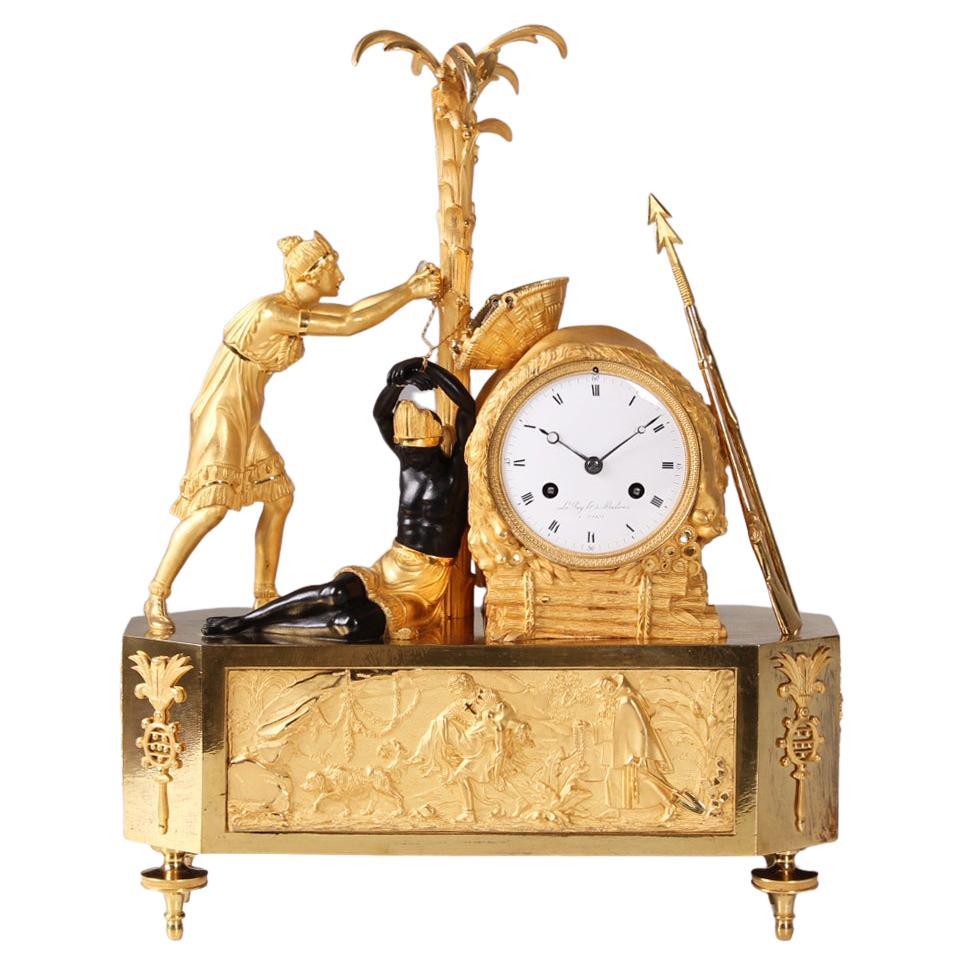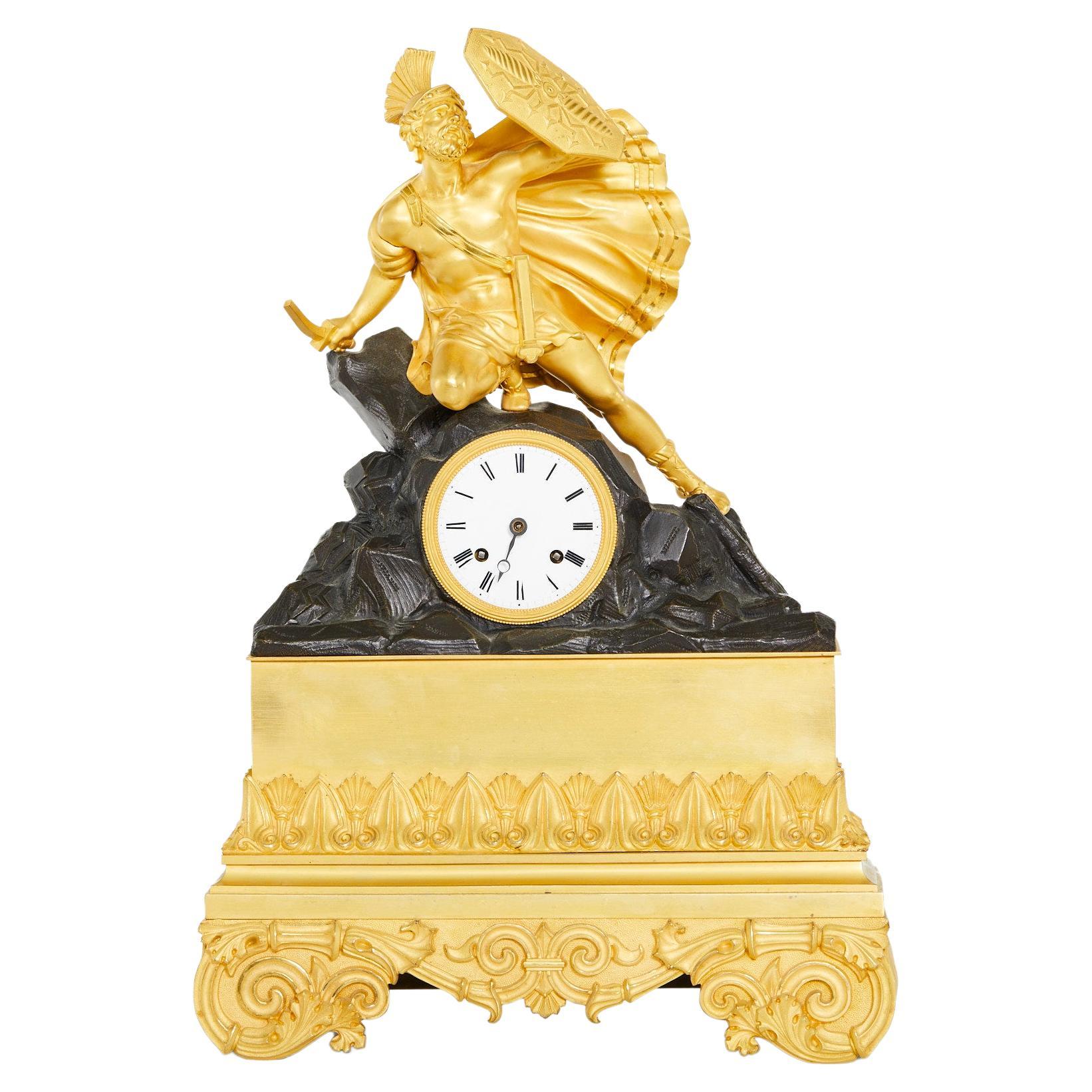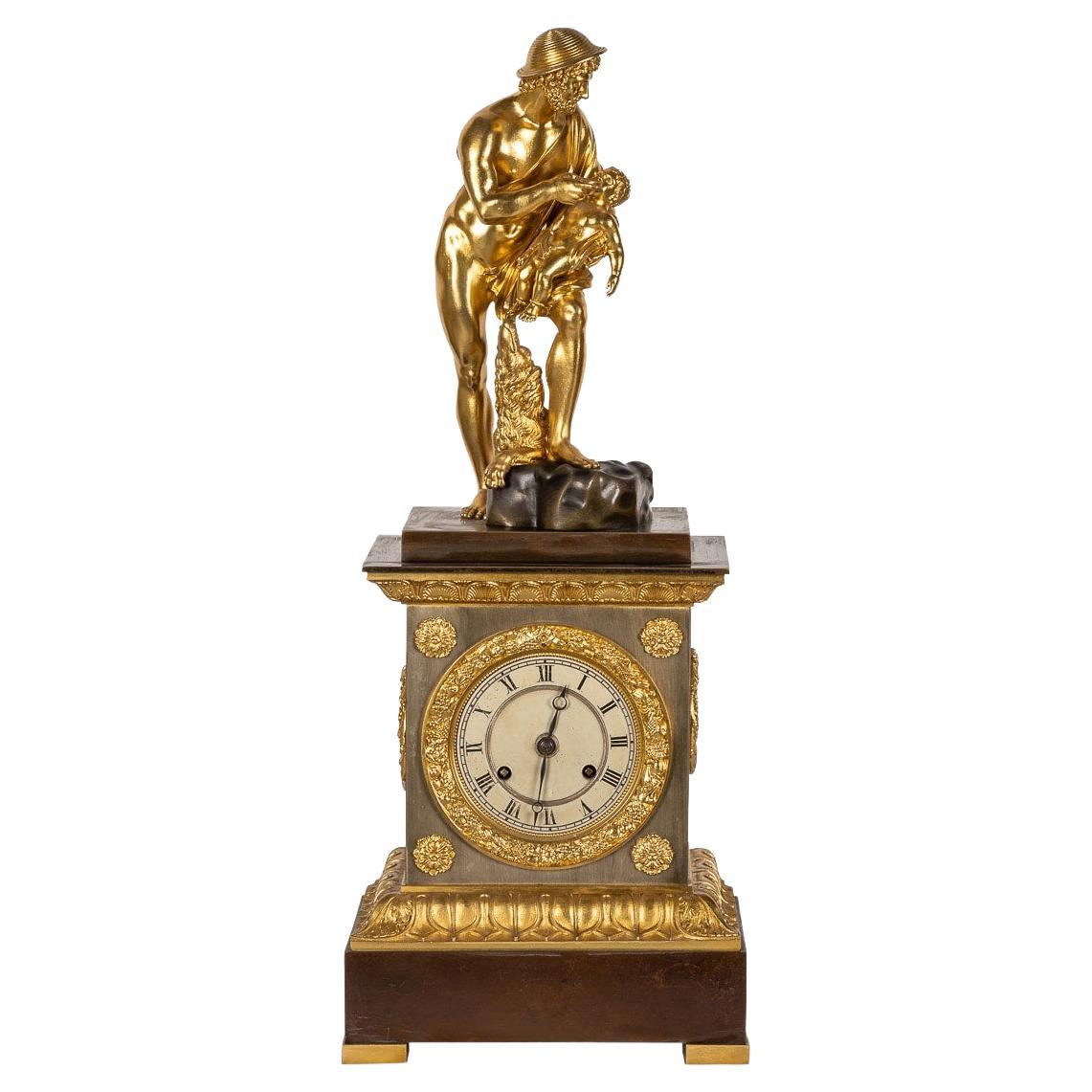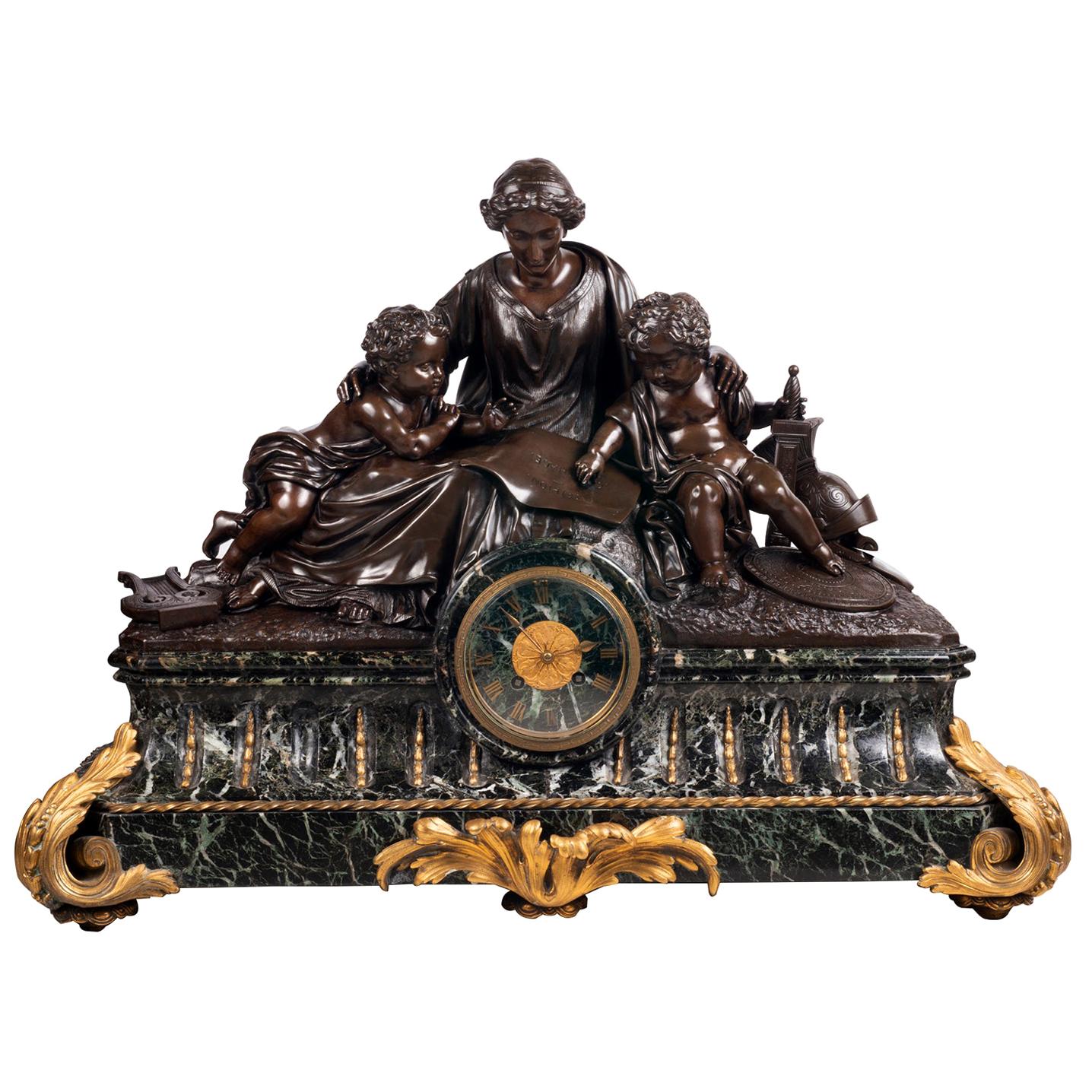Items Similar to Early 19th Century Mantel Clock, Firegilt Bronze, Paris circa 1810
Video Loading
Want more images or videos?
Request additional images or videos from the seller
1 of 18
Early 19th Century Mantel Clock, Firegilt Bronze, Paris circa 1810
About the Item
Very rare "Au Bon Sauvage" mantel clock
France
Fire-gilt and patinated bronze
Empire around 1810
Dimensions: H x W x D: 34 x 41 x 13 cm
Description:
Extremely rare French bronze mantel clock from the early 19th century in marvellous condition.
The central pedestal relief shows cornucopias and laurel tendrils as well as a caduceus - or Mercury's staff - symbolising trade and a paddle symbolising seafaring. Both allude to the flourishing trade with the French colonies. The corner appliqués also pick up on this theme with an anchor, rope and trident.
However, the main focus is on the fully sculpted bronze depiction above. It depicts a young man pushing a wheelbarrow with a bale of cotton. A parrot sits on the front of the barrow. The movement is embedded in the bale and the pendulum swings through an opening under the base.
The high quality of the bronze work and the balance of the overall composition are impressive. The dark patination of the body contrasts wonderfully with the original fire gilding and the white of the enamelled dial.
The 8-day pendulum movement strikes a bell on the half and full hour. The thread suspension of the pendulum and the lock disc striking mechanism are typical of the period.
Interesting facts:
The model shown here with the wheelbarrow was probably designed shortly after the Portefaix. The Portefaix is the best-selling clock from the "Au bon Sauvage" model series today and was also the best-selling clock back then. The figure of both models is identical, except for the position of the arms. Nevertheless, the clock with the wheelbarrow could not compete with the Portefaix in terms of sales figures.
The Journal des Dames et des Modes reported on the great success of the Portefaix in October 1807 and then wrote two months later: "Inspired by the great success of the pendulum clock (Portefaix), which consists of a bale of cotton transported on a wheelbarrow, the bronze dealers imagined that a clock with the bale placed on a wheelbarrow would be a second bestseller. But the wheelbarrow became a slow seller."
If you look at the examples of the wheelbarrow that have survived to this day, however, you come to the conclusion that this clock also found its buyers. However, it was obviously produced in much smaller numbers than the Portefaix and is therefore very rare in the art trade today.
The motif of the cart actually originates from the everyday life of ordinary people in Paris. Merchants and craftsmen travelled the streets shouting and singing, offering their goods and services. The romanticised lifestyle of the shouting merchants made them a popular motif in art. Copperplate engravings by Abraham Bosse (1604-1676) and François Boucher (1703-1770), among others, are already known from the 17th and 18th centuries, showing vendors with a barrel of vinegar on a wheelbarrow.
Meissen also took up the motif of calling merchants in the mid-18th century and published a 35-piece series of porcelain figurines under the name "Cris de Paris", including a vinegar seller.
After the great success of the Portefaix, a related, highly marketable motif was sought and found in the vinegar seller, whose depiction was now used in an exotically modified form.
Condition:
Wonderful, authentic condition. The movement has been overhauled and works perfectly.
There is an old repaired spot on the rear carrier of the wheel axle. Technically this is well done. The spot is clearly visible in the photo showing the back of the clock.
This model can be found in various reference books:
Pierre Kjellberg - Encyclopédie De La Pendule Francaise p. 344
Musée Francois Duesberg p. 67
Jean-Dominique Augarde - Une Odyssée En Pendules II p. 446
- Dimensions:Height: 13.39 in (34 cm)Width: 16.15 in (41 cm)Depth: 5.12 in (13 cm)
- Style:Empire (Of the Period)
- Materials and Techniques:
- Place of Origin:
- Period:
- Date of Manufacture:1810
- Condition:Wear consistent with age and use. Wonderful, authentic condition. The movement has been overhauled and works perfectly.
- Seller Location:Greven, DE
- Reference Number:1stDibs: LU5419238685282
About the Seller
5.0
Platinum Seller
These expertly vetted sellers are 1stDibs' most experienced sellers and are rated highest by our customers.
Established in 2014
1stDibs seller since 2020
114 sales on 1stDibs
Typical response time: <1 hour
- ShippingRetrieving quote...Ships From: Münster, Germany
- Return PolicyA return for this item may be initiated within 14 days of delivery.
More From This SellerView All
- Early 19th Century Ormolu Mantel Clock, Atala freeing Chactas, Paris, circa 1810Located in Greven, DEMantel Clock "Atala and Chactas" Paris Bronze (fire-gilt and patinated), enamel Empire around 1810 Dimensions: H x W x D: 40 x 32 x 11 cm Description: Very rare and extremely high quality French mantel clock, so-called Pendule Au Bon Sauvage. Depicted are scenes from the love story "Atala or the love of two savages in the desert" written by Francois René Vicomte de Chateaubriand in 1801. At the beginning of the 19th century, this was probably the most famous love story in Europe, but today it has been forgotten. The story, set in present-day Louisiana (USA), is roughly rewritten about the forbidden love between Chactas, a young Indian, and Atala, the beautiful daughter of a Spaniard. Chactas is captured in a battle between two Indian tribes, chained to a palm tree and is to be sacrificed. Atala wants to save his life and convert him to Christianity. She unties him from the palm tree at night and they flee together into the wilderness of North America. Their love for each other grows stronger and stronger and they have prospects for a future together. The story takes a tragic turn when Atala, who must remain a virgin due to a vow made by her mother, can no longer withstand the conflict of her feelings and commits suicide. The main group of characters thus shows Chacta's liberation through Atala. Atala is leaning against a pile of logs. The animal fur thrown over the logs and the weapons leaning against the stack on the right give the impression of a night camp. The bronze is of rarely beautiful quality, finely chiselled and makes the scene appear very lively. The contrast of fire-gilded and patinated bronze adds tension to the composition. In the base we see the Entombment as the end of the tragic love story. This bronze work is also very detailed, the interplay of bright and matt gilding makes the flat relief appear much deeper than it is. The depiction of the mantel clock presented here shows that the exotic was only known from stories and that the bronzier had his own ideas about the appearance of this distant world. The Indian, for example, has very European facial features and his skin was not black in reality, of course. The palm tree was also certainly not found in the North American wilderness. The heart of the clock is a French pendulum movement, integrated into the wooden pile, with an eight-day power reserve and a lock plate striking a bell on the half and full hour. The pendulum is suspended on a thread, typical of the period. The classically shaped hands, so-called Breguet hands, are also typical of the time. The enamelled dial has black Roman hour numerals, Arabic quarter hours and bears the signature: Le Roy hr. de Madame A PARIS. Interesting facts: The period from 1795 to about 1815 saw the creation of probably the most spectacular group of bronzes: The "Au bon Sauvage" pendulums - depictions of the "Noble Savage". Today's viewers react to these objects with both fascination and irritation. Enthusiastic on the one hand about the obvious quality of the detailed bronzes and the allure of the exotic, on the other hand distanced and cautious because of the possible discrimination that is suspected behind them. The ambivalence of this feeling motivates the search for the conditions of origin of these pendulums. Europeans found their new ideal of the natural man primarily in fictional and realistic travelogues about the Indians of North America...Category
Antique Early 19th Century French Empire Mantel Clocks
MaterialsOrmolu
- 19th French Empire Mantel Clock, Pendule, Mercury, Gilded Bronze, circa 1815Located in Greven, DE19th century French pendule, mantel clock - Mercury the messenger of the gods France Bronze gilded Empire around 1815 Dimensions: H x W x D: 37 x 30 x 10 cm Description: French Empire...Category
Antique Early 19th Century French Empire Mantel Clocks
MaterialsBronze
- 19th Century Mantel Clock "Astronomy", France circa 1830Located in Greven, DEAntique mantel clock on the theme of astronomy France Bronze Charles X around 1830 Dimensions: H x W x D: 48 x 19 x 10 cm Description: Unusual and beautifully crafted bronze mante...Category
Antique 19th Century French Charles X Table Clocks and Desk Clocks
MaterialsBronze
- 19th Century French Ormolu Mantel Clock, circa 1840Located in Greven, DE19th Century French mantel clock France (Limoges) Ormolu around 1840 Dimensions: H x W x D: 37 x 22 x 10 cm Description: The bronze, cast in relief and then fire-gilded, stands on...Category
Antique 1830s French Charles X Mantel Clocks
MaterialsMarble, Bronze, Ormolu
- 19th Century Miniatur Mantel Clock, Gare La Bombe, Cupido, France, Gilded BronzeLocated in Greven, DEPendulette "Gare La Bombe" France gilded bronze first half 19th century Dimensions: H x W x D: 20 x 15 x 7 cm Description: Antique miniature mante...Category
Antique Early 19th Century French Empire Mantel Clocks
MaterialsBronze
- French Empire Ormulu Bronze Mantel Clock, Lepaute, Thomire, Paris, circa 1815Located in Greven, DEOrmulu pendule with depiction of friendship and love Paris (Lepaute, Thomire) fire-gilt bronze Empire around 1815 Dimensions: H x W x D: 44 x 36 x 13 cm French pendulum movement with eight days duration. Thread suspension and lock disc striking movement with strike on bell on the half and full hour. White enamel dial with Roman hour numerals and Breguet hands. Signature: LePaute & Fils / Hrl. du Roi (Pierre-Basile Lepaute (1750 - 1843) with his son Pierre-Michel Lepaute (1785-1849); from 1811 in joint workshop). Description: The extremely high quality pendulum shown here takes up a profound theme: Friendship, which combines with love and can thereby outlast time and death. As it is typical for the epoch of classicism, personifications and symbols are taken from the fund of ancient mythology and art and then developed further. The main figure is a young woman in an antique, girded garment, standing barefoot and with crossed legs next to an altar, on which she is leaning with her left elbow. She gracefully bows her head towards a tempestuously approaching Cupid, grasps his right hand with her left and draws him to her bosom, the seat of the heart. The delicate ambivalence of flying towards and being held culminates in the trustingly intimate look that the two cast at each other. The young woman personifies friendship, the winged Cupid love. As a sign of their intimate connection, two burning hearts appear on the altar next to the two, framed by the puffed scarf, which are closely bound together by a chain of flowers. Next to them, on the altar slab, one can see an erected book with the title "Amitie" (French: amitie, friendship). Supporting the book is a pomegranate held by a ring of pomegranate flowers. The bursting seeds spill out of the cracked skin. Since ancient times, the pomegranate and its blossoms have been dedicated to the goddess Persephone, symbolizing the underworld and death, but also life and fertility. The myrtle interwoven in the pomegranate flower wreath of "friendship" also has a far-reaching symbolic power: the plant was dedicated to the goddess Aphrodite, stands for virginity, and was and is therefore obligatory in the bridal wreath...Category
Antique Early 19th Century French Empire Mantel Clocks
MaterialsBronze, Enamel
You May Also Like
- Bronze Mantel Clock, 19th CenturyLocated in Madrid, ESTable clock. Marble and bronze, 19th century. Table clock with Paris box machinery made of marble and bronze and with porcelain plates applications with roc...Category
Antique 19th Century European Neoclassical Mantel Clocks
MaterialsBronze, Other
- Early 19th Century Gilt Bronze Figural Mantel ClockLocated in Tarry Town, NYEarly 19th century Charles X style gilt bronze with figural design detail mantel clock. The clock features a surmounted soldier holding a shield. Eight day spring driven brass moveme...Category
Antique Early 19th Century French Charles X Table Clocks and Desk Clocks
MaterialsBronze
- 19th Century French Empire Style Bronze Mantel Clock, circa 1870Located in Royal Tunbridge Wells, KentAntique 19th century French Empire style gilt bronze mantle clock. The foliate and fruit engraved gilt-brass dial with enamel painted roman numerals. Inside with eight day movement w...Category
Antique 19th Century French Empire Mantel Clocks
MaterialsBrass, Bronze, Enamel
- Early 19th Century Empire Ormolu-Mounted Bronze and Marble Mantel ClockBy Pierre-Victor LedureLocated in New York, NYA fine quality empire ormolu-mounted patinated bronze and rouge royale marble mantel clock. The patinated bronze figures depicting cupid and psyche. Attributed to Pierre-Victor Ledure...Category
Antique Early 19th Century French Empire Mantel Clocks
MaterialsMarble, Bronze, Ormolu
- Large 19th Century Bronze Mantel ClockLocated in Brighton, SussexA large and impressive very good quality 19th century French Louis XVI style mantel (fireplace) clock, having a bronze mother and two children ...Category
Antique 19th Century French Louis XVI Mantel Clocks
MaterialsMarble, Bronze
- Mantel Clock 19th Century EmpireLocated in Warsaw, PLFigural mantel clock signed “Al. dre Destape Palais Royal” The bronze figural mantel clock depicting one of the mythical heroes - Orpheus originates from the Empire period. The cloc...Category
Antique Early 19th Century French Empire Mantel Clocks
MaterialsBronze
Recently Viewed
View AllMore Ways To Browse
Parrot On A Swing
Meissen Relief
Louis Xvi Neoclassical Gilt Bronze
Vase And Clock Set
Roman Antique Mask
French Porcelain Champleve Urns
Hermes Mantel Clock
Grohe Clock
Tiffany Mercury Clock
Jaeger Lecoultre Vintage Chronograph
Balance Ancienne
French Chinoiserie Mantle Clock
Maison Barbot Clocks
Patek Philippe Rate
Patek Philippe World Time Minute Repeater
Sessions Mantel Clocks
Art Deco Kienzly
Astro Clock





